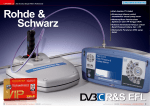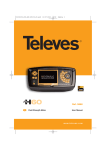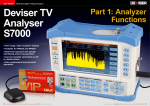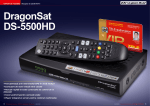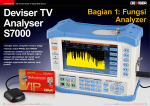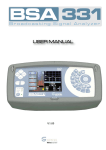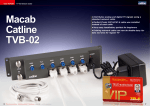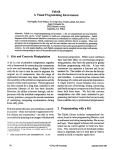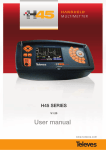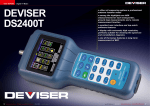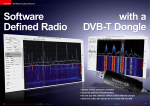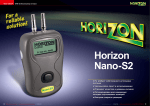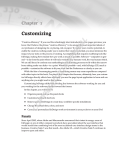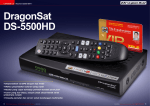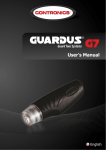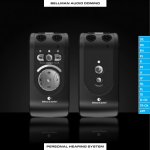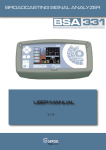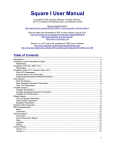Download Test Report Rohde & Schwarz R&S®EFL
Transcript
TEST REPORT Professional DVB-C Signal Analyzer Rohde & Schwarz 22 TELE-audiovision International — The World‘s Largest Digital TV Trade Magazine — 03-04/2014 — www.TELE-audiovision.com •Top of the Line Cable TV Analyzer •Specially Designed to Detect Leakage Signals •Displays the Entire Spectrum from FM to WiFi •Special Directional Antenna for the Aircraft and LTE Bands •Enables Compliance with the Strictest EMS Regulations R&S EFL www.TELE-audiovision.com — 03-04/2014 — TELE-audiovision International — 全球发行量最大的数字电视杂志 23 TEST REPORT Professional DVB-C Signal Analyzer Signal Analyzer That Provides the Perfect Installation and Leakage Measurement of Cable TV Networks Rohde & Schwartz is wellknown for their high-quality test instruments that can be found primarily in laboratories and R&D departments. For mobile applications the company has developed the new EFL product line for use by technicians to check and measure an installation. One of the products from this series, the R&S EFL210, is especially interesting. It has been conceived for the installation and maintenance of cable TV networks with emphasis on the maximum attenuation of leakage signals. The analyzer comes with a matching antenna and it‘s this combination of the R&S EFL-210 analyzer and R&S EFL-Z100 antenna that we put to the test. Both of these products come shipped in a very sturdy hard plastic case that was designed to be used in extreme outdoor conditions. Inside the case the analyzer and antenna are further protected by a solid foam material that perfectly fits the R&S EFL-210 analyzer and R&S EFL-Z100 antenna. There are also cutouts in the foam to securely store the accessories such as the power supply, coaxial cable and various connectors. In one of these storage cutouts you‘ll also find two special carrying straps that allow you to carry the EFL210 analyzer on your body. Due to the size of the antenna, the carrying case for the analyzer is actually quite large: it measures about 52cm (20.5in) wide x 42cm (16.5in) long x 22cm (8.6in) high and weighs about 10 kg (22 LBS) with all of its accessories. One thing is for sure though: this case definitely 03-04/2014 Rohde & Schwarz EFL210 + EFL-Z100 The best and most complete professional instrument for CATV operators and their installers. www.TELE-audiovision.com/14/03/rohde-schwarz 24 TELE-audiovision International — The World‘s Largest Digital TV Trade Magazine — 03-04/2014 — www.TELE-audiovision.com provides the best protection for its contents. At first glance the analyzer itself looks rather unusual in that it isn‘t a typical rectangular construction. Instead it has a rounded, almost oval shape to it. It won‘t take long though for you to realize the reason for this ergonomic shape: the R&S EFL210 sits very comfortably in your hands and can easily be operated with both thumbs as can be seen by the ring buttons located on the right side. The analyzer can be securely held in your hands while at the same time all of its functions can easily be accessed. Particularly clever are the three eyelets on which the carrying strap is attached. This allows the technician to carry the R&S EFL210 and have both hands free at the same time. This can be especially crucial if you need one hand to adjust the antenna and the other hand to hold on to something. This carry- ing strap system is different from other systems that use only one strap that hangs around your neck. Through a three-point system the analyzer also has a strap that wraps around your waist. In this way the R&S EFL210 doesn‘t dangle around the upper part of your body, something that many technicians have to live with every day and turns out to be a safety hazard if, for example, you‘re walking around on scaffolding. 1 The front panel features a set of buttons on the left side and the right side. The set of buttons on the left side includes four buttons in the shape of a cross to navigate through the different menus (up, down, back, and OK) as well as a button to access or exit the menu and an additional button to take you to the Main menu. The Power button that turns the analyzer on/off is located on the lower left alongside four LEDs. Three of the LEDs show the status of the rechargeable battery (external power source, internal power source and battery is charging) while the fourth LED illuminates when the R&S EFL210 is turned on. On the right side is a „touch-knob“ that simulates a mechanical rotating knob; instead of turning a knob, you merely pass your finger (the thumb would be best) over the touch knob. The touch sensor works perfectly making it easy to use, for example, for extreme fine frequency adjustments. The sensitivity of the sensor can be adjusted to your personal tastes in the analyzer settings but the default settings worked just fine for our tests. the button for 2-3 seconds. To further increase the technician‘s productivity, two additional buttons are reserved as function buttons that can be programmed by the user to any desired function. Surrounding this touchknob are another 15 buttons that provide direct access to all of the R&S EFL210‘s functions. After a short break-in period you‘ll hardly need to access the menu since lessused menu pages can be accessed through an additional function of these buttons, namely pressing and holding In the middle there‘s a high-resolution color monitor that is exceptionally bright. It has a resolution of 640x480 pixels and parameters such as brightness, contrast and color can, of course, be adjusted as needed. There‘s also a special mode that provides for exceptional monitor readability. 1. The menu structure of the R&S EFL210 at one glance. One can see that great care has been taken to provide a user friendly and logical menu structure that allows to quickly access all functions of this instrument. 2. Start screen of the Rohde & Schwarz EFL210. 3. The equipment info screen. Throughout the test I was using the latest firmware version. 4. Let’s start configuring the R&S EFL210. The built-in pre-amp can be turned on or off and you can select the preferred units for the measurements. This device can be set to an automatic mode, which will then output the common units for different measurements. This is a highly appreciated new feature. 5. Support for many different languages. 6. Using external amplifiers or other active elements like switches or a LNB the output voltage can be set. The included R&S EFLZ100 antenna needs to be powered with 13V for the LTE band. 7. In the Antenna menu select between two pre-configured R&S antennas, the EFLZ100 (included) and the R&S HE-300. Two further antenna settings can be configured by the user, who can then also set the correct antenna factor (K). The K value expresses the antenna gain for a given frequency in MHz. 8. A unique feature with the R&S EFL210: it can be pre-configured for up to four different applications. 9. The R&S EFL210 can be configured for low power consumption, which will allow for a longer autonomy when running on batteries. The drawback will be a less bright screen, but it might get you around for a particularly work intensive day. The auto mode will try to give the best relation of brightness and speed against battery autonomy. 10. Being a handheld measuring instrument for field use the R&S EFL210 features a memory logger that allows to store the measurements made. 11. There are different options within the Memory/Logger menu. It is possible to store the measurements and graphs and to access SD type memory cards. This is particularly important as technicians are often on the field for days, generating a lot of information. Using SD cards, the data can be copied to them and read on a PC without connecting the R&S EFL210, allowing to write reports, while the instrument is still available for measurements. The MACROS option allows to define a set of measurements exactly tailored to the individual need. Once setup, you just run the macro and the instrument will do all measurements automatically. 12. Doing a regular scan. The R&S EFL210 will tune all frequencies of the selected plan and provide a quick PASS/FAIL information view, recording all relevant measurements. These are stored and can be recalled at any time. 13. The R&S EFL210 supports SD cards with sizes up to 2GB; SDHC cards are not supported. 2 4 6 8 10 12 3 5 7 9 11 13 26 TELE-audiovision International — The World‘s Largest Digital TV Trade Magazine — 03-04/2014 — www.TELE-audiovision.com On the top side of the analyzer you‘ll find the HF input. As you might expect with a professional instrument, the input jack is designed to be used with a variety of swappable connectors („F“ connector, BNC connector, etc.) that are naturally included with the analyzer. There‘s also a slot for an SD memory card available (unfortunately, only SD cards up to 2GB are recognized; SDHC cards are not compatible), a USB interface that allows you to connect the R&S EFL210 to a PC, an HDMI output and the power www.TELE-audiovision.com — 03-04/2014 — TELE-audiovision International — 全球发行量最大的数字电视杂志 27 supply jack. A speaker and a recessed Reset button are also provided. On the rear panel you‘ll find a stand that can be opened into two positions so the analyzer can be comfortably used on a table. Two cooling vents on either side of the analyzer provide sufficient ventilation for the R&S EFL210. Overall, the analyzer felt very solid and robust even though it didn‘t feel all too heavy. Particularly striking is its unusual design that after only a few minutes impressed us with its outstanding ergonomics and convenient operation. To help us get used to using the R&S EFL210, we first started playing with the otherwise normal functions you‘d find in cable TV measurements. Here you can setup, measure and display analog and digital transponders as long as they are not encrypted. For a channel scan the standard cable TV frequency lists are preprogrammed into the analyzer although you can easily and comfortably edit and expand this list from your PC. More on that later. The following measurements can be performed with analog signals: ● ● ● ● ● ● Level V/A C/N C/N L Field Strength Bandwidth ● Display of reception parameters ● BER ● MPEG: Channel list and video display with MPEG2 and MPEG4 support ● Constellation diagrams ● Evaluation of uncorrectable packets Measurements such as BAR Scan (simultaneous signal level display of multiple channels in bar graph form) and TILT (skew) that can be found in many other CATV signal analyzers are not available in the R&S EFL210. It would be nice to have these functions to, for example, properly set up an amplifier so that all of the frequency ranges would have a uniform signal level. But there‘s a reason that these 28 TELE-audiovision International — The World‘s Largest Digital TV Trade Magazine — 03-04/2014 — www.TELE-audiovision.com extra functions are missing; the R&S EFL210 includes a spectrum analyzer that in the end is a much better alternative! Thanks to the logical menu structure and sufficient number of buttons, using the R&S EFL210 is a piece of cake. We were able to work with all of the measurements in CATV mode without having to refer to the user manual. Especially useful is the simultaneous display of the image and the spectrum. Although the displayed image is distorted, it is still easy to determine the quality of analog signals by simultaneous analysis of the spectrum. The R&S EFL210‘s spectrum analyzer highlights the 14. Measuring analogue CATV channels is very simple and quick. Just select the required frequency and off you go. All relevant information is displayed in one single screen and PASS/WARNING/FAIL icons show immediately if the channel to noise ratio, video to audio ratio and signal level are adequate. 15. If only one measuring parameter is important it can be displayed exclusively in a larg font. 16. One of the special features of the R&S EFL210 is its capability of mixing different information into one single screen. For analogue channels visualizing the image is often not enough. Being able to evaluate the line signal allows to check for example if the sync signals are within conformity. 17. This oscilloscope functionality can be displayed individually. It is possible to select the line to be analyzed and to zoom in. 18. Zooming in reveals some noise within the line blanking interval. Despite having an acceptable picture quality, this shows a potential problem. 19. A different visualization mode shows the demodulated image next to the spectrum view of the current transponder. The relevant measurements are displayed as well. 20. The tuner and demodulator are of the finest quality and despite the considerably weak signal a good image is rendered. This only shows how important it is to rely on the measurements and explains why you can never use a normal receiver or TV to evaluate a CATV signal. 21. One interesting measurement is the channel/noise ratio of a selected video line. Instead of measuring against an average of all lines you can select a specific line, against which you measure the ratio to the noise level. This is very handy if you are working with test pictures, where the desired pattern occupies only part of the image. 22. You can specify the level thresholds. Once the set level is reached the instrument stops the search. The search function can be done in both directions and the spectrum updates in real-time, following the frequency. 23. Once a channel is found with at least the specified signal level the search stops and immediately the measurements are presented. 24. To make the channel tuning easier it is possible to select from a list of predefined channel plans. I have created my own channel plan, covering all analogue channels of my cable operator using the R&S EFL Suite on the PC. 25. Configuring the audio. 14 18 22 15 19 23 16 20 24 17 21 25 30 TELE-audiovision International — The World‘s Largest Digital TV Trade Magazine — 03-04/2014 — www.TELE-audiovision.com 26. All measurements clearly visible at one glance: Frequency, CBER, Signal Power, C/N Ratio and MER. Notice that CBER is shown twice: once along with the other measurements and then a second time in a bigger format. On the bottom you get the list of services contained in the current transponder. 27. Pressing the MENU button will show further options. You can edit the reception parameters, visualize BER with more detail, and display the MPEG picture, the constellation diagram or a statistic with how many uncorrected packets are being received. 28. This screen allows to edit the reception parameters. Notice that the deviation of the Symbol Rate is automatically calculated and shown. All of these values can be set to automatic and in most situations the R&S EFL210 will be able to automatically tune to the QAM transponder. 29. Here we see the demodulated MPEG picture. The R&S EFL210 supports both MPEG-2 and MPEG-4, so you are always prepared for whatever standard is being used. The OSD shows the CBER along with the relevant channel PID’s and MPEG information. 30. The constellation diagram is fast and functional. 31. With QAM64 you get four quadrants and you can zoom into each one of the four. 32. This will allow analyzing the constellation in more detail. If you give the meter a few seconds it will display MER and CBER as well, thus allowing a complete analysis of the signal. Note that CBER is the Bit Error Rate before the error correction algorithm is applied. While the BER after the correction is useful to effectively see what amount of errors the demodulator will have to deal with it is the CBER that you want to evaluate to get an idea on how stable the reception will be. Many problems in the constellation diagram can only be understood and resolved by simultaneously considering the constellation diagram, MER (modulation error ratio) and CBER. Hence it is a great feature of the R&S EFL210 to provide all three measurements in one screen. This is by no means common in CATV analyzers. 33. Better than a Bit Error Rate after the error correction: the R&S EFL210 gives a complete statistic on uncorrected packets! These are shown in number and time interval, i.e. how much time passed since the last uncorrected packet appeared. Each uncorrected packet will produce a glitch in the TV image, so it is nice to have this measurement running over a small period of time to understand if the reception is indeed acceptable or not. It can be used to spot intermittent problems, too. 34. I especially like this measurement screen: one can see the demodulated picture, the PID’s and MPEG info’s together with CBER. This is a quick and simple way to confirm if everything is OK. Notice that the rather borderline measurements of my CATV service is due to the fact that I am using a very poor signal on purpose to see how the tuner of the R&S EFL210 handles weak signals. You can see the results: no problem for the R&S EFL210 26 29 32 27 30 33 28 31 34 32 TELE-audiovision International — The World‘s Largest Digital TV Trade Magazine — 03-04/2014 — www.TELE-audiovision.com strength of this device: the spectrum is displayed not only in real-time but also provides a frequency span of 2500 MHz. In this way you‘d be able to observe the entire frequency spectrum from FM all the way up to WiFi! lephony. In a perfect world, there wouldn‘t be any signal leakage from the cable network, but, of course, the real world looks quite different. Various leakage signals can manifest themselves and could be caused by the smallest imperfection in a coax cable or an improperly attached connector. In addition to standard functions like the ability to place markers (maximum of three different markers) to calculate frequency and level/power offsets, RBW and VBW filters can also be individually customized. Also, the sweep rate can be selected from three different modes: normal, fast and special accuracy. This is especially practical for a technician; this function automatically selects the ideal RBW and VBW values for each selected mode. Even utilizing defective passive or active components could cause signal leakage; and especially with these types of defects the coax cable could end up behaving like a transmitting antenna that, depending on the type of defect, would broadcast the signal in the coax cable across various frequency ranges. That‘s why there are specific regulations and recommendations that dictate what kind of leakage and how much of it can be toler- 35. This is a detailed view of the selected CATV transponder. Using a span of 10MHz with a RBW filter width of 100kHz the transponder is rendered with a very nice detail. Individual carriers can be identified and the refresh rate is in real time. 36. The same frequency but with a 20MHz span and a RBW filter settings of 200kHz. 37. Now with 50MHz span. Everything is still rendered in smooth real time. 38. At the 100MHz span the RBW filter automatically adjusts to an 800 kHz window, since you could not benefit from a higher resolution anyway, because of the fixed screen resolution 39. Smooth real time spectrum with a 200MHz span, which outperforms any other spectrum analyzer I have tested so far in the CATV bands. 40. To shorten it up: with an amazing 2GHz span and the RBW filter set to 6.4 MHz width the spectrum is still very detailed and rendered in smooth real time. 41. And yet the R&S EFL210 managed to surprise me with real time spectrum on a full span of 2.5GHz. Congratulations to Rohde & Schwarz! 42. Measurements of analogue signals are represented by a signal level while digital signals use the signal power. In order to correctly represent the measurement at In cable networks, the higher frequency signals are distributed into the 50 to 2150 MHz range. The result is that a large amount of data in a variety of different modulations is simultaneously transported, namely: radio, analog TV channels, digital TV transponders, broadband Internet and te- ated before it becomes too much. Signal leakage has become even more prevalent since the introduction of LTE (4G) mobile networks for broadband Internet. Cable network operators therefore need to painstakingly test and protect their cable networks against any signal leakage. And it‘s exactly this problem that the Rohde & Schwartz EFL210 with the di- the marker frequency you can select which mode you are interested in. 43. Within the spectrum you can now measure in the analogue mode: Level, V/A (video to audio ratio), C/N (channel to noise ratio), Field Strength and the Bandwidth. 44. Another nice and useful feature: the R&S EFL210 shows an automatic quality assessment of the signal. If you get a green checkmark, everything is OK. Yellow means that you have weak signal quality and red indicates no reception. A technician can see this result immediately, without having to think about the measured values. This increases So, how is this done? The productivity and makes the job easier. 45. Here you can measure Power, C/N, BER (Bit Error Rate) and bandwidth. Measuring bandwidth of the transponder can be very useful for unknown transponders. 46. Measuring the C/N, also known as frequency noise, shows the difference between signal power and noise power. 47. Here I am measuring the bandwidth of a digital QAM64 transponder. The transponder uses more than 7 MHz. 48. Moving the markers I could determine that the bandwidth of this transponder was indeed 8 MHz. 43 46 35 37 39 41 44 47 36 38 40 42 45 48 34 TELE-audiovision International — The World‘s Largest Digital TV Trade Magazine — 03-04/2014 — www.TELE-audiovision.com rectional antenna EFL-Z100 were meant to be used for: this compact measurement instrument makes it possible for the technician to quickly and easily test a cable network for any signal leakage, locate it and then eliminate it. This instrument also simultaneously functions as a cable TV analyzer that can be used on both analog and digital cable signals. www.TELE-audiovision.com — 03-04/2014 — TELE-audiovision International — 全球发行量最大的数字电视杂志 35 ■ Handling both the R&S EFL210 and the R&S EFL-Z100 is an easy task. The antenna is not too heavy and the straps are very comfortable around the neck. Thanks to the ergonomic shape of the instrument and its circular button grid, you can access all functions with your thumb. 36 TELE-audiovision International — The World‘s Largest Digital TV Trade Magazine — 03-04/2014 — www.TELE-audiovision.com 49 50 51 49. Our calibrated Test Source generates test signals at user defined frequencies and power levels. The test signal is of extreme accuracy, making it the ideal way of testing the R&S EFL210. And indeed, this picture does not lie: using the HDMI-output of the R&S EFL210 connected to my test computer (which has a HDMI capture card), I put both windows side by side. Look at the result: I generated a -40 dBm signal at 130 MHz and on the other side of the cable, the R&S EFL210 measured -40.7 dBm at exactly 130.00 MHz. An excellent result. 50. I repeated the same test at 180 MHz. Now I got only -0.1 dBm deviation. 51. At 950 MHz I got -0.2 dBm difference. 52. Again, only -0.5 dBm difference at 1450 MHz 53. Finally, at 2150 MHz, the deviation was +0.1 dBm. 54. Wondering, why I got a higher deviation at the first measurement, I decided to repeat 55 52 56 53 57 54 58 the measurement at 130 MHz and now I got 0 dBm deviation. The truth is that any deviation under 1 dBm is an amazing precision for any HF instrument and the R&S EFL210 beats hands down all our meters, including the reference devices. And why did I get a better result this time? Because you should allow any measuring instrument to warm up properly if you want the most accurate results. 55. The REF LEVEL option is normally called “MAX HOLD” in other devices. It will continually show the highest value measured within the spectrum. 56. First I activated the waterfall display. The picture illustrates the frequency sweep of the signal source generator. 57. Using the REF LEVEL option turned on and allowing for a full sweep the spectrum shows the continuous frequency measurement. I normally try this on all spectrum analyzers and I can assure that this is by far the best result I have seen so far. The maximum value forms practically a horizontal line with very little variation. 58. In this picture I did a frequency sweep over a whopping 1GHz span. Again, the results are fantastic. Remember that on this sweep the R&S EFL210 only gets 1 second to adjust itself to the signal at a given frequency to measure it and to update the REF LEVEL. leakage measurement is performed using a waterfall diagram. It shows the spectrum over a specific time period where each spectrum is represented as a colorcoded line: black and dark colors signify a weak level while light colors indicate a high signal level. We already reported on this type of display in TELEaudiovision several times (in the 12-01/2012 and 0203/2012 issues). The waterfall diagram provides for a continuously running overview of the spectrum over a time span of seconds or minutes depending on how fast the waterfall diagram of the spectrum scrolls across the screen. This is perfectly suited to quickly finding the source of any leakage signal by slowing moving a directional antenna back and forth. The R&S EFL-Z100 is the perfect directional antenna for the job. It consists of four pieces: the antenna itself, a hand grip that can be installed in two different positions, as well a two metal rods that can be attached to the antenna on the sides turning the antenna into a dipole (needed when working in the aircraft band). When measurements are 38 TELE-audiovision International — The World‘s Largest Digital TV Trade Magazine — 03-04/2014 — www.TELE-audiovision.com performed in the LTE frequency range, these dipoles are not attached. The R&S EFL-Z100 is an active antenna with an integrated amplifier. This antenna was designed to work best on the mostoften encountered and most dangerous leakage frequencies: the aircraft communications band and the LTE mobile frequency band. Rohde & Schwartz went a step further and calculated the antenna factor for those two frequency bands and stored them in the R&S EFL210. The antenna factor (AF or K-factor) is calculated using the formula AF=E/V and represents the ratio between the electric field strength E of the incoming radiation with respect to the output voltage V of the antenna. But when you use the R&S EFL-Z100 antenna, you don‘t have to worry about any of this: simply select this antenna from the antenna menu and you‘re ready to go. ■ Since the R&S EFL210 does not allow to record screen shots Naturally, you can also connect any antenna you like to the EFL210 but then you would have to correctly define the antenna factor yourself. This antenna definition can only be entered on a PC with the R&S EFL Software Suite. Since the antenna factor is depend- ant on the actual frequency, the antenna configuration in the R&S EFL Suite involves entering a table: for each frequency a corresponding K-factor can be entered. The ■ View of a building with CATV cables. Let's see if this doesn't produce some leakage. Guess what: yes it does. of the waterfall diagram in leakage mode I did my best to take a pictures of the screen: notice that to the left of the DVB-T transponder at 754 MHz there is a lot of leakage from the CATV visible (in blue color). The reading in the waterfall diagram is not constant, because I am swinging the R&S EFL-Z100 antenna around, in order to determine the exact location of the leak. user can store two self-defined antennas in the analyzer in addition to the already predefined EFL-Z00 directional antenna and another R&S antenna, the R&S HE- www.TELE-audiovision.com — 03-04/2014 — TELE-audiovision International — 全球发行量最大的数字电视杂志 39 ■ To measure in the aeronautics band, you need to use the two dipoles attached. The 13V power feed can be turned off, as amplification will increase the gain only marginally. 40 TELE-audiovision International — The World‘s Largest Digital TV Trade Magazine — 03-04/2014 — www.TELE-audiovision.com Aero 59. A span of 5MHz may be a small span for CATV and satellite technicians but it is a huge span for radio communication specialists. Thanks to the very narrow RBW filter of just 18 kHzW you can clearly see all radio communications happening within the selected span. In this case a pilot is speaking to the tower. 60. Here you see the tower’s reply. Because our test center is just 10 km away from the airport we can clearly receive such communications. The waterfall display allows to register all communications within the span over a period of time. Notice that the R&S EFL210 displays the signal level accurately in µV/m, which is the correct unit to measure EMI. 61. No transmission happening now on 121.10 MHz, the frequency used by the OPO airport tower. Imagine the consequences of a leakage, generating interference on this frequency. This could severely disrupt the communication between pilot and tower on a landing maneuver. 62. This picture shows the full span of aeronautics frequencies. This span is universally used throughout the world. Gladly no leakage could be detected in the test center, otherwise we would have to immediately correct the problem. 63. Here we see a communication happening on a different frequency. With the R&S EFL210 I can now visually detect any radio communication in this band at a glance, instead of having to scan through known frequencies or doing a frequency search. FM 64. A pre-programmed frequency range is available to monitor the FM radio band. This allows to analyze if interferences occur between 88 Mhz and 108 MHz. Any radio station can naturally be tuned in by the R&S EFL210 and the audio is reproduced. 65. View of the FM band with a 20 MHz span. Individual radio stations can clearly be identified. GSM 66. The full span of the GSM band. Two frequencies are being used, but with a faint signal. This is normal, since I am using a smartphone with GPRS and EDGE frequencies and usually GSM mode is turned off. There is no other cellphone using GSM in vicinity, either. Also, no leakage. This was to be expected, because cable operators avoid putting transponders at frequencies this high. LTE 67. Leakage measurement with the R&S EFL-Z100 antenna. You can clearly see the DVB-T transponder at 754 MHz and the neighboring LTE transponder at 800 MHz. Some transmission is happening at 742 MHz. 68. The transmission at 742 MHz is highly directional: pointing the R&S EFL-Z100 antenna to a different direction, nothing is detected at this frequency. 69. The same happens to the mobile phone transponder at 786 MHz. Further rotation of the R&S EFL-Z100 and this transponder disappears as well. 70. This is what leakage looks like. You can clearly see the DVB-C transponders, despite the fact that I was using the directional R&S EFL-Z100 antenna a few 64 70 59 65 71 UHF 60 66 72 WiFi 61 67 73 62 68 74 63 69 75 meters away from the coaxial CATV cable. This should never happen in real life, as it means that radiation is coming out of the coaxial cable, interfering with radio services. 71. The leakage is directional and with the current orientation of the antenna, no leakage is detected (spectrum in the upper half of the screen). However, the waterfall diagram clearly shows that leakage was registered within the last seconds, when the antenna was pointing to a different direction. If you slowly move the antenna from left to right, you will quickly find the source of the leakage! 72. The antenna is pointing at the leakage again, the CATV transponders are clearly visible in the spectrum. Notice how the waterfall diagram shows a faint signal which is getting stronger as the antenna points toward the leakage source. This is an extremely useful functionality of the EFL-210: you won’t just determine that there is leakage occurring, you will indeed find the source very quickly. download happening on my laptop, which is connected to the access point by Wi-Fi. Interesting fact: we have a pretty good Wi-Fi connection in our test center, because there are no interfering signals caused by access points from neighbors or other services like analogue video transmitters or wireless security cameras (both normally use the 2.4 GHz frequency range). 73. The waterfall diagram shows the UHF section of the CATV cable in our test center. You can clearly distinguish analogue transponders from digital transponders: the thin lines belong to the analogue transponders. Notice that they come in pairs – one line is the video carrier, the other the audio carrier. 74. Using an antenna no CATV transponders are found, which means that there is no leakage in this frequency range. The signal you see comes from different radio applications – I am using a radio scanner antenna. 75. Because the R&S EFL210 can deal with frequencies up to 2.5GHz it is possible to analyze the 2.4GHz Wi-Fi frequency range as well. In these pictures you can see a 42 TELE-audiovision International — The World‘s Largest Digital TV Trade Magazine — 03-04/2014 — www.TELE-audiovision.com www.TELE-audiovision.com — 03-04/2014 — TELE-audiovision International — 全球发行量最大的数字电视杂志 43 ■ Often though, the source used a very simple trick: the MAX Hold function was utilized. This feature continuously shows the highest measured values and is normally used, for example, to perfectly align an antenna. In this case with an active MAX Hold function, the spectrum registers the „wandering“ power level. You merely have to wait until it has gone through the entire spectrum. of the leaks were not the splitters of the CATV operators. ■ Leakage in the LTE band is determined using the R&S EFL-Z100 antenna without the dipoles and with the internal amplifier turned on. For this you simply activate the 13V power on the RF connector. It is reassuring to hear a slight click inside the antenna, signaling that the amplifier is active. Our conclusion regarding measurement precision? The R&S EFL210 is not just a simple signal analyzer, it‘s a fully featured test instrument. If you use this Rohde & Schwartz unit to make a measurement, you can be sure that the measured values will be absolutely correct. ■ Walking along the street I was impressed on how much leaked radiation I could pick up. 300, that with it‘s swappable modules can be used for the 9 kHz to 7.5 GHz range. For our TELE-audiovision tests, a simulated leakage signal was created here in the test center to get a feel for how the analyzer works and from what distance the leakage can be detected. At the same time it gives us an opportunity to get used to using the R&S EFL-Z100 directional antenna. Since this particular antenna is designed primarily for the aircraft and mobile LTE bands, the frequencies from 108 to 139 MHz and from 700 to 800 MHz can be analyzed in a waterfall diagram. The first task was to use the EFL-Z100 directional antenna to check for both frequency bands here in the test center. For the FM and aircraft bands, the antenna is used with the dipoles in- 44 TELE-audiovision International — The World‘s Largest Digital TV Trade Magazine — 03-04/2014 — www.TELE-audiovision.com serted and the amplifier turned off. No leakage signals could be detected. For the LTE frequency band, the dipoles are removed and the amplifier is turned back on. This activates the 13V at the R&S EFL210‘s HF connector output. Once again, no troublesome leakage signals could be found. This isn‘t at all surprising considering that our cabling adheres to certain directives. Now the actual test could start. Leakage signals were artificially generated so that there was something to measure. Our test setup was actually quite simple: we merely inserted a small dipole antenna into the cable TV port. Sure enough, from several meters away and even through a wall we were able to identify some QAM transponders very close to an LTE transponder at 800 MHz (see photos). With analyzers like the R&S EFL210 it can be difficult to compare measurement results from the spectrum display with other analyzers. Why? Because the R&S EFL210 displays the spectrum in a higher resolution thus letting you identify individual carriers within a transponder. Of course, the signal strength varies considerably depending on the content of the transmitted data. If you want to be able to compare different analyzers side-by-side, you‘d have to set up all of the parameters equally, such as, range as well as RBW and VBW filters. But it would be difficult to do this because of the differences in the settings of each device. You would also have to hope for uniform data transmission. A far better way to check the precision of a signal analyzer like the R&S EFL210 is to measure a synthetically created signal with known parameters. That‘s why we used a calibrated signal generator to test the measurement precision of the R&S EFL210. To that end we generated a signal at various frequencies and at different power levels and measured it with the R&S EFL210. It‘s quite impressive to see how precise the measured values turned out. Measurements that are off by less than 1.0 dBm are incredibly precise and even a sweep over various frequency ranges delivered consistent results, something that really only can be achieved with high-quality hardware. To measure the sweep we Naturally, Rohde & Schwartz also includes the necessary Windows software with the EFL210, the R&S EFL Suite. With this software, measurement protocols using the stored Logger files in the EFL210 can be created. You can also edit channel lists and it‘s even possible to create frequency tables and so-called Macros. Specifically, these memory frequency tables (MEM) together with these Macros makes it possible to automatically create measurement protocols whereby the R&S EFL210 automatically sets up and measures the preprogrammed frequencies. This is an excellent timesaving way to perform the same measurement at different points in an installation. CATV installers would especially benefit from this since the frequency table from the cable provider would only need to be programmed once via Macro. From that point on, it would www.TELE-audiovision.com — 03-04/2014 — TELE-audiovision International — 全球发行量最大的数字电视杂志 45 ■ Notice how I am holding the antenna. For me, this was the most comfortable configuration. If you prefer, you can screw the handle of the antenna rotated 180 degrees and hold it upside down. 46 TELE-audiovision International — The World‘s Largest Digital TV Trade Magazine — 03-04/2014 — www.TELE-audiovision.com 76 77 Amateur Radio 76. It happens occasionally that a customer complains about intermittent TV reception. Often the cause is an amateur radio enthusiast, who is using inadequate equipment. The picture shows the waterfall diagram of a transmission done with a cheap handheld radio, emitting at 145 MHz. Interestingly, the radio disturbs a nearby transmission at 148.5 MHz. Notice that the waterfall diagram shows that transmission, whenever the radio is not transmitting. 86 78 This happens, because the radio has not so good band pass filters, which produce second harmonics that are stronger than expected. This second harmonics is visible as the first smaller line to the right of the main signal. 77. This is the spectrum view around the center frequency of 145 MHz wcith a 20 MHz span. The hand held radio is not transmitting in this picture, thus the transmission at 148.5 MHz is not being disturbed. 78. See what happens in this picture, when 79 you use the cheap hand held radio: lots of harmonics, obfuscating all transmissions in vicinity. With the R&S EFL210 you can uncover problems resulting from such devices very easily and in an affordable way. Thanks to the included directional antenna you even get to know where the transmission is coming from, if the interferences are within the supported bands of the R&S EFL-Z100 antenna. Otherwise you can use the R&S HE-300 antenna, which covers the whole spectrum from 9 kHz to 7.5 GHz, thanks to its modular design. 80 81 84 48 TELE-audiovision International — The World‘s Largest Digital TV Trade Magazine — 03-04/2014 — www.TELE-audiovision.com 88 The Rohde & Schwarz EFL Suite 82 85 83 87 89 79. The main window of the R&S EFL Suite. 80. The R&S EFL210 is connected to the PC using a USB cable. However, the interface will actually create a virtual serial port (RS-232) for the EFL Driver. It is a good idea to check the Device Manager to confirm that the driver has been properly setup and to read the COM port number. If your computer has other COM ports, for instance because you have a Bluetooth adapter, you will get some odd COM port like I did: in my case it is COM16. You may need to manually configure the R&S EFL Suite to use the specific COM port. 81. The About screen of the R&S EFL Suite. I tested the latest v4.15. 82. No doubt a useful feature: you can import your company logo and input your company details. They will then be included in the automatically generated reports. 83. Next configuration: Which COM port is attributed to the R&S EFL210? Hopefully you did as I suggested and looked it up in the device manager. 84. Once connected the R&S EFL Suite will read out the memory of the instrument. This takes only a few seconds. 85. On the right side you can now choose what you wish to download from the instrument to the computer: data logs, graph logs (actual screen shots) or channel plans. 86. The data logs can be viewed on the PC and you can check them, so that they are included in the report generated by the R&S EFL Suite. 87. A perfect looking report, generated automatically by the R&S EFL Suite and using our custom logo and company information. 88. Of course you can generate reports with screen shots as well. 89. Just select which screen shots you want to include, using the “Mark to print” option. It is great that you can export these screen shots as regular pictures, too. This way you can use your own report templates, for instance using Microsoft Office products. www.TELE-audiovision.com — 03-04/2014 — TELE-audiovision International — 全球发行量最大的数字电视杂志 49 90. The R&S EFL Suite allows to edit the channel plans and of course you can create your own customer channel plans. This is required when you are working for a CATV provider, who uses specific transponder frequencies. Just program them once and off you go. 91. Another interesting feature of the R&S EFL210 is the possibility to create macros, which are basically frequency lists that you select to be automatically measured. In the first step you need to create a “Memory”, which is basically a transponder. You need to configure the transponder by inputting its channel number or frequency value and specifying if it is an analogue or digital transponder. 92. Once you have your “Memory” definitions setup, you can switch to the Macros tab and create a macro. Select a name and put the required memories inside. After uploading the memories and macros to the R&S EFL210, you can select the macro and execute it. The R&S EFL210 will then tune each memory and perform the measurements, storing the results automatically in the instruments memory. This is particularly useful, when you need to measure the same transponders over and over. 90 91 always be available to the installer to test the installation of a customer. With the R&S EFL Suite two additional user-defined antennas can be set up in case other antennas would be used besides the R&S EFL-Z100 and the R&S HE-300. The operation of the R&S EFL Suite is not at all complicated and doesn‘t first require reading a user manual even though a browser-based user manual is available. We really appreciated the import/export capabilities to Microsoft Excel. 92 In this way you‘re not dependent on the functionality of the R&S EFL Suite; you can, for example, also use Microsoft Word to create protocols. This would hardly be necessary since the protocols generated by the R&S EFL Suite actually look quite good and can even be supplemented by a company logo. Overall, we very much liked the R&S EFL Suite; you‘ll enjoy using it. There are still a few bugs in the current version but they will be corrected by Rohde & Schwartz in an upcoming update. For example, when the software is linked with the R&S EFL210, it incorrectly states that a new firmware update is available when in reality that update is only for the R&S EFL240 and R&S EFL340 models. The R&S EFL210 signal analyzer is the ideal solution for cable operators and their subcontractors that are responsible for the installation and maintenance 50 TELE-audiovision International — The World‘s Largest Digital TV Trade Magazine — 03-04/2014 — www.TELE-audiovision.com 93. When the spectrum is shown in real time it only needs to render 25 to 50 images per second, which is the LCD screen’s refresh rate. However, when looking at analogue or digital transponders the signal varies much quicker. This means that the spectrum analyzer shows the average or maximum signal level within the refresh rate period of the spectrum. Toggling the VBW Filter, you can actually determine the time period that is used to average the signal level. The left picture shows a VBW filter setting of 1 kHz, while the right one shows a VBW filter setting of 15 kHz. Which is better? That is up to the technician to decide: a lower filter will show a more averaged spectrum, which is easier to interpret, while a higher filter setting will show a more “nervous” spectrum, which shows more detail about what is happening on each single frequency. Notice how you can detect the carriers of the transponder. The downside is a more difficult-to-read spectrum, since transponders get harder to distinguish 93 94 of cable networks. In just a single device the signal, regardless if it‘s analog or digital, can be measured and displayed while at the same time a large assortment of functions are also available to measure leakage signals. The fact that the R&S EFL210 comes with a spectrum analyzer that can display an enormous range of 2.5 GHz is unheard of in an analyzer of this class and definitely helps the technician create a picture of multiple frequency ranges. As you would expect from a Rohde & Schwartz product, its measurement precision is extremely high and yet it‘s very easy to use. From its unique shape to the arrangement of all of its buttons, everything is just right. Given the ever increasing responsibility of the cable TV operators and installers in terms of compliance with maximum permissible interference, the R&S EFL210 is the ideal reference solution. Spectrum Analyzer Operation and the Function of the RBW and VBW Filters The R&S EFL210 signal analyzer comes with a professional and fully featured spectrum analyzer. Unlike most other standard satellite and cable analyzers, with the R&S EFL210 you can set up RBW and VBW filters to your personal requirements. But what are these filters exactly? In order to answer this question you first have to understand how a spectrum analyzer works. With the R&S EFL210 the HF input signal is converted to a small frequency range by a bandpass filter that is then digitized and inserted into the spectrum through Fast against the background noise. 94. The effect of different RBW Filter configurations: all pictures show the same transponder. On the left picture you see the result of using a resolution bandwidth of 200 kHz, the middle picture uses a resolution bandwidth of 800 kHz and the right picture has the resolution bandwidth set to 1.6 MHz. The bigger the bandwidth, the faster the refresh rate of the spectrum. A faster spectrum reacts quicker to any signal variation, allowing you to see things faster and to detect short timed signals. Don’t worry with the R&S EFL210: all shown resolution bandwidths will be rendered in real time. These pictures are just to show the effect of the RBW filter. What is really important is to be able to adjust the RBW filter to the current span: if you are using a wide span, you want to use a higher resolution bandwidth to maintain the refresh rate of the spectrum high. If you are using a narrow span you want to have maximum resolution, instead. The R&S EFL210 excels in the spectrum analyzer mode. Fourier Analysis (FFT). This frequency range is continuously swept across the selected range. This spectrum analysis implementation is called „Hybrid Super Heterodyne FFT“ and offers the best compromise between an analog spectrum (without FFT analysis and thus lower resolution and precision) and a pure „Realtime FFT“ spectrum (FFT analysis across the entire frequency range, something that can only be accomplished with extremely high computing power and multiple parallel running FFT analyzers). In fact, the R&S EFL210 functions with a remarkable FFT bandwidth of 20 MHz. This makes it possible, for example, to simultaneously analyze the entire LTE frequency band. The RBW filter (Resolution Bandwidth) specifies the frequency bandwidth that the bandpass filter allows to pass through. The smaller the frequency bandwidth, the higher the resolution of the 52 TELE-audiovision International — The World‘s Largest Digital TV Trade Magazine — 03-04/2014 — www.TELE-audiovision.com resulting spectrum. But this higher resolution requires more time to calculate the spectrum and in turn more time to generate it. If, on the other hand, a larger frequency bandwidth is selected for the bandpass filter, the spectrum display is generated much more quickly but with a lower resolution. With the R&S EFL210 the RBW parameter is automatically set so that the resolution of the spectrum is as close as possible to the resolution of the display: it doesn‘t make any sense to generate a spectrum with a resolution that is higher than the display itself can handle. Naturally, the bandwidth of the R&S EFL210‘s RBW filter can also be set manually. This would make sense when, for example, two neighboring signals can only be differentiated with maximum resolution. The RBW filter can be set from 300 kHz to 6.4 MHz. The VBW filter is a Video Bandwidth filter. Once the HF signal has passed through the VBW filter, it is digitized by the detector. The signal is digitized multiple times and, depending on the setting of the spectrum function, a maximum value or an average value is calculated. The video bandwidth sets the sensitivity with which two measured signal levels can still be differentiated. And just like before, the higher the sensitivity, the slower the generation of the spectrum display. The R&S EFL210 supports video bandwidths from 100 Hz to 1 MHz. expert OPINION Rohde & Schwarz EFL210 Professional DVB-C meter Vitor Martins Augusto Test Center Portugal Measuring Satellite and Terrestrial Antennas with the R&S EFL210 Although the R&S EFL210 was not conceived for satellite antenna installations and doesn‘t come with a corresponding demodulator, it‘s still possible for the technician to set up satellite antennas with this analyzer. For one thing the R&S EFL210 can display the required spectrum from 950 MHz to 2150 MHz with every possible function in real time. The R&S EFL210 is also capable of supplying the necessary 14V and 18V for the LNBs as well as switching between vertical and horizontal polarization. The only thing missing is the 22 kHz signal to switch between the low and high bands. But it would be good enough to install and align a small satellite antenna. It‘s important to note that an installer working under contract to a provider who sets up both CATV and satellite reception systems would save themselves the cost of a second analyzer. RECOMMENDED PRODUCT BY + ● Allows a span over the whole 2.5 GHz frequency band ● Configurable RBW and VBW filters ● All common measurements available for spectrum: signal/ power level, bandwidth, up to three markers ● Integrated CATV analyser with analogue and digital measurements (signal/power level, C/N, MER, BER, constellation diagram, etc.) ● Demodulator for analogue Radio and TV, MPEG-2 and MPEG-4 ● Leakage measurement through waterfall diagram in selected frequency bands (FM, Aeronautics, VHF, UHF, LTE, GSM and WIFI) ● Includes directional antenna for aeronautic and LTE frequency band ● Allows to measure leakage to comply with EMI regulations ● Easy and intuitive operation ● Highest accuracy – ● Does not allow to capture screenshots in Leakage mode The same scenario exists with the sporadic use of the R&S EFL210 in aligning antennas for terrestrial digital TV. Here the excellent real-time spectrum would help and even amplifiers and active antennas could be used with the available 5V, 14V, 18V and 24V. If you need to set up antennas for DVB-T/T2, you could also use the R&S EFL210. 54 TELE-audiovision International — The World‘s Largest Digital TV Trade Magazine — 03-04/2014 — www.TELE-audiovision.com

















